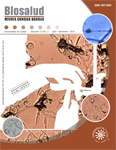Authors
Abstract
Introduction: For the clinical laboratory is important to have a sample that meets the requirements for analysis, reason why the clinical chemistry laboratory demands its patients to fast 8 hours in order to take the urea, creatinine and ALT analyses since the metabolism of food may be reflected in the serum changes and may cause interference in the reading of these analytes. The purpose of this work is to review how much interference occurs when the sample is read 2 hours after breakfast. Materials and Methods: Total, pre and postprandial blood samples for ALT, urea and serum creatinine analysis were taken for this study in order to establish the possible interferences glucose, cholesterol and triglycerides may cause in the analysis. The ANOVA test was used for the variance analysis and interferogram was used in order to determine the type of interference and its significance. Results: ANOVA test showed no significant differences in the results and interferogram did not show significant differences for any of the analytes of interest in this study. Discussion: The ALT, urea and creatinine analysis in fed postpandrial conditions suffer positive interference in some patients due to glucose, cholesterol and triglycerides contained in the sample. This interference is not significant which suggests that it is not necessary to fast when the sample is going to be taken when it can be taken 2 hours after breakfast with a previous 8 hour fast.
Keywords
References
Castaño JL, Amores C. Interferencias causadas por la turbidez (lipemia) en la determinación de 14 constituyentes séricos. Química Clínica 1989; 8(5):319-322.
Rodríguez N, Torres D, Carvajal M. Confiabilidad del Método de Jaffé modificado por Laboratorios Heiga para la determinación automatizada de la Creatinina. Rev Fac Farma 2001; 42(2):55-62.
Castaño JL. Interferencias endógenas y exógenas en el analizador Hitachi 917. Química Clínica 1999; 18(3):129-141.
Theofanis P, Christos A, Christos P. A nephelometric turbidity system for monitoring residential drinking water quality. Nicosia, Cyprus: University Cyprus; 2012. p. 43-55
Sánchez MA, Colunga R, Cedillo M. Ecuaciones para eliminar la interferencia de sueros hemolisados, ictéricos e hiperglucémicos en las determinaciones rutinarias de química clínica. Bioquimia 2002; 27(2):46-52.
Croll H, Martin J. Elin R. Interference with clinical laboratory analyses. Review. Clin. Chem. 1994; 40(11):1996-2005.
Acebo-González D, Hernández-García AT. Los métodos Turbidimétricos y sus aplicaciones en las ciencias de la vida. CINEC, Ciencias Biológicas 2013; 44(1) Vol. 44, No. 1, enero-abril, 2013.
Castaño JL. Estudio de las interferencias analíticas endógenas en química clínica. Química Clínica 1994; 13(2):84-92.
Agudelo M, Ortega V, Olivera M. Efecto de la hemólisis de la muestra de sangre canina en el resultado de algunos analitos enzimáticos. Revista Biosalud 2014; 13(1):21-29.

 PDF (Español)
PDF (Español)
 FLIP
FLIP














